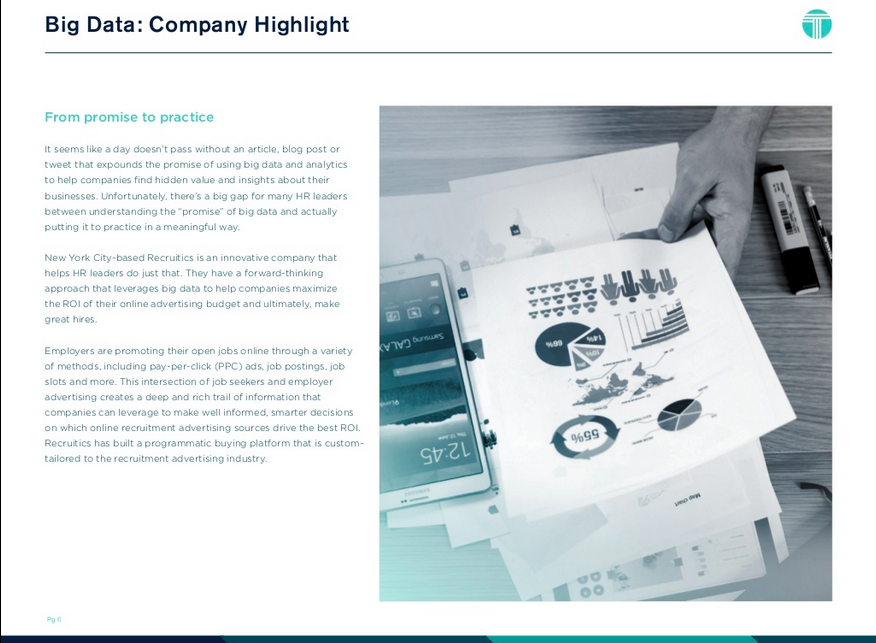This is an excerpt from the Talent Tech Labs Trend Report for Q3 2015. To view the full trend report, click here.
Big data is transforming every industry, but its impact on talent acquisition technology is palpable. And it’s more than a trend; big data is poised to make a bigger talent acquisition business impact than ever. The applications of big data in HR are profound, most specifically focusing on better and faster ways of aligning job opportunities and job seekers. However, human resources leaders need to not only understand the value of big data in HR, but also understand how to put it into practice. At Recruitics, we’re doing just that.
Employers are promoting their open jobs online through a variety of methods, including pay-per-click (PPC) ads, job postings, job slots and more. This intersection of job seekers and employer advertising creates a deep and rich trail of information that companies can leverage to make well informed, smarter decisions on which online recruitment advertising sources drive the best ROI. Recruitics has built a programmatic buying platform that is custom-tailored to the recruitment advertising industry.
Making smarter decisions with your online recruiting advertising spend.
While there is a range of data available to help you better manage your online advertising spend, understanding which data you should be measuring is key to avoiding information overload and truly seeing results.
- Know Your Conversion Rates.
Job postings are your honeypot. They are how you attract job seekers to apply to your jobs. Therefore, you first need to be able to answer a simple question: Are my job postings working? From a data perspective, the “lowest hanging fruit” to determine if your job postings are working is your conversion rate. A simple definition of conversion rate is the number of times a job is viewed divided by the number of applicants you get to a job. For example, if a job is viewed 1000 times, but only has 10 applications, it has a 1% conversion rate. That’s a job posting that is simply not working for you. You could invest thousands of additional ad dollars into that job to drive more applicants, but if it is only converting about 1%, you’ll simply be wasting your money. Instead, stop spending on that particular job and identify the reason it is not converting viewers into applicants, and ultimately, hires.
- Track the performance of every job.
Every job and job seeker is different, so it is critical that you map an online advertising strategy to maximize the performance of every job. There are multiple factors that determine the effectiveness of an individual job posting. For example, it is likely that the success of certain ad sources (e.g. Indeed, LinkedIn, CareerBuilder etc.) varies based on the type of job you are trying to fill. Jobs also perform differently based on the day of the week and the time of day they are advertised. They also perform differently based on the job title or the content of the job description. If you are unable to measure all of these aspects at the job level, you will never achieve optimal ROI on your advertising spend. But more importantly, this is something that is best suited for a “computer” and not a person. There are simply too many dimensions to track and evaluate in order to accurately and consistently manage for performance.
- Stop spending when you have met your goal.
Another common problem you may encounter is actually getting too many applicants to your jobs. From a budget perspective, every additional applicant you receive but don’t need is spend you’re taking away from an in-demand position—particularly if you are working in a PPC or cost-per-applicant (CPA) model. Therefore, you want to have some idea of what your applicant “goal” is for every job. Think about a job that you are sourcing for now. What is the number of applicants you think you need before you will get an appropriate number of interviews to fill that position? Whatever that number is, that’s your applicant goal and the point when you want to stop spending ad dollars. Establishing that goal and having a system in place to track your ad spend to programmatically alter and stop spending when said goal has been hit, is critical to driving high ROI.
The advent of big data in HR has enabled companies like Recruitics to take advantage of all of these data points to programmatically manage your online advertising spend.
This is an excerpt from the Talent Tech Labs Trend Report for Q3 2015. To view the full trend report, click here.




